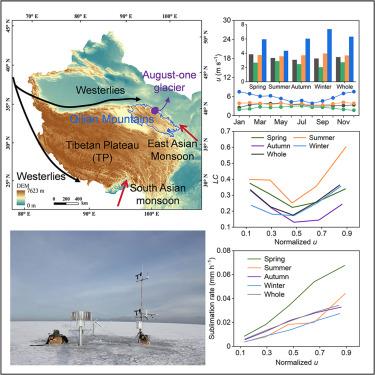IF 4.1
2区 综合性期刊
Q1 MULTIDISCIPLINARY SCIENCES
引用次数: 0
摘要
结果表明,西风占总升华损失的67%(频率60%)。西风下的升华主要由风速控制,抵消不利的湿度/温度梯度。同时,西风将能量通量的优势从净辐射(Rnet)转移到感热(H),其贡献了52%的地表能。随着西风的增强,H的贡献减少,而升华的作用由于潜热通量的增强而升级。这项工作确定了风速是西风主导系统中升华的主要控制因素,为预测气候驱动环流变化下冰川质量损失提供了一个机制框架。本文章由计算机程序翻译,如有差异,请以英文原文为准。

Westerly winds impact glacier energy balance and sublimation at August-one glacier in northern Tibetan Plateau
Mid-latitude westerlies critically regulate glacier mass balance on the Tibetan Plateau. Here, we analyze the meteorological variables, surface energy balance (SEB), and surface sublimation of the August-one glacier (located in the northern edge of the Tibetan Plateau (TP), with a high altitude and relatively flat top) under different wind directions to better understand the effects of westerly winds on this glacier. Results show that westerly winds (60% frequency) drive 67% of total sublimation loss. Elevated sublimation under westerly winds is primarily controlled by wind speed, counteracting unfavorable humidity/temperature gradients. Simultaneously, westerly winds shift energy flux dominance from net radiation (Rnet) to sensible heat (H), which contributes 52% of surface energy. As westerly winds intensify, H contribution declines while sublimation’s role escalates due to enhanced latent heat flux. This work establishes wind speed as the dominant control on sublimation in westerly-dominated systems, providing a mechanistic framework to project glacier mass loss under climate-driven circulation shifts.
求助全文
通过发布文献求助,成功后即可免费获取论文全文。
去求助
来源期刊

iScience
Multidisciplinary-Multidisciplinary
CiteScore
7.20
自引率
1.70%
发文量
1972
审稿时长
6 weeks
期刊介绍:
Science has many big remaining questions. To address them, we will need to work collaboratively and across disciplines. The goal of iScience is to help fuel that type of interdisciplinary thinking. iScience is a new open-access journal from Cell Press that provides a platform for original research in the life, physical, and earth sciences. The primary criterion for publication in iScience is a significant contribution to a relevant field combined with robust results and underlying methodology. The advances appearing in iScience include both fundamental and applied investigations across this interdisciplinary range of topic areas. To support transparency in scientific investigation, we are happy to consider replication studies and papers that describe negative results.
We know you want your work to be published quickly and to be widely visible within your community and beyond. With the strong international reputation of Cell Press behind it, publication in iScience will help your work garner the attention and recognition it merits. Like all Cell Press journals, iScience prioritizes rapid publication. Our editorial team pays special attention to high-quality author service and to efficient, clear-cut decisions based on the information available within the manuscript. iScience taps into the expertise across Cell Press journals and selected partners to inform our editorial decisions and help publish your science in a timely and seamless way.
 求助内容:
求助内容: 应助结果提醒方式:
应助结果提醒方式:


